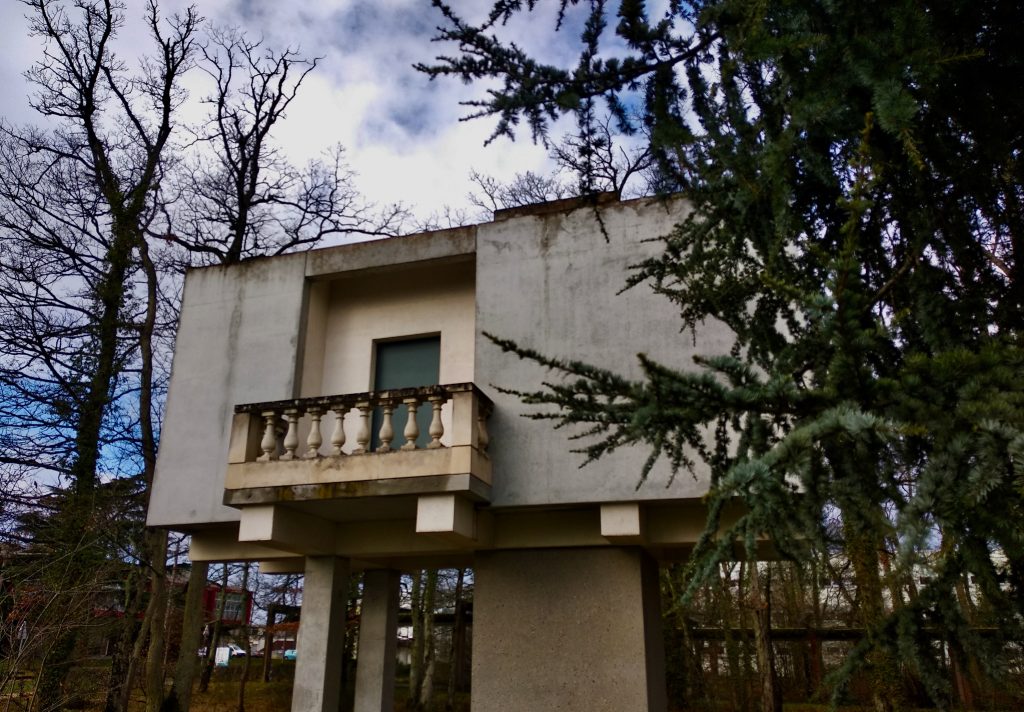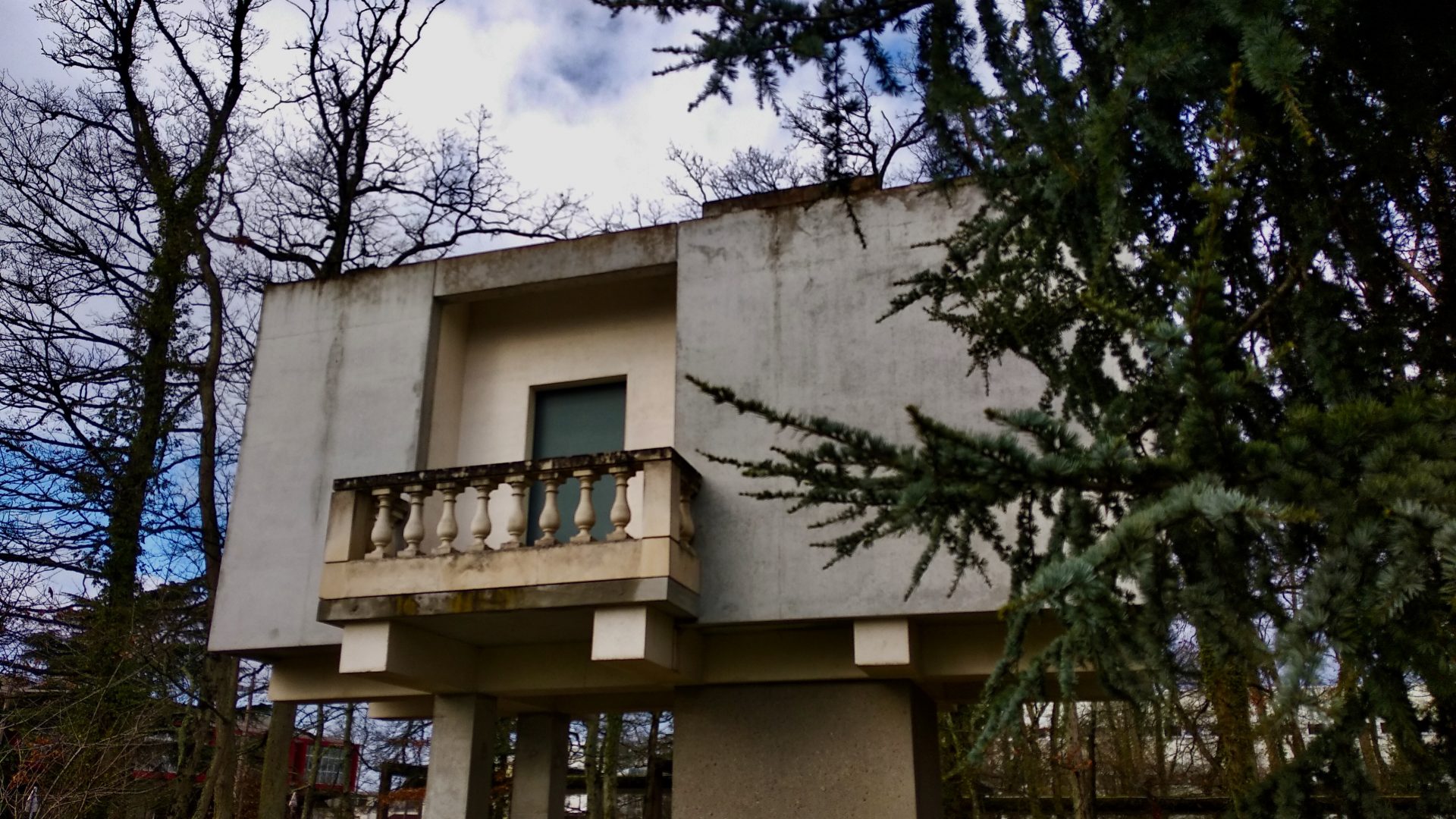This romantic work was imagined and realized by the artist Jean-Marc Bustamante in the 2000s. Although located on the La-Source campus, the University of Orleans is not the sponsor of the artwork. The Love Room is in fact the result of an order from the community of communes of Orleans during the construction of the first line of the tramway, as part of the “artistic 1%” obligation. You can admire it on the university campus, near Polytech and the tram station “Université Parc Floral”.

The Love Room : a curiosity
Due to its design, the Love Room is an artistic and architectural curiosity. As its name suggests, the work represents a room, in the shape of a parallelepiped. It is 8m long and 3.75 m wide, and it is supported by stilts 3m high. This high up room is not accessible : there are no stairs, no elevator, and the window has no opening devices. This “bedroom” has a chimney and a glass window opening onto a balcony, which explains why the Line A tram drivers nicknamed the artwork “The balcony of Romeo and Juliet”. Originally, a light mechanism was installed behind the window to provide random lighting.
At first impression, the geometric shape of the work and the reinforced concrete that composes it gives it a raw, cold appearance. The ornamentation of the work is minimalist and simple. The balusters with a bulging body (i.e with a rounded shape) of the balcony oppose to the straight lines and the dominant geometric shapes in the structure of the work. The shape of the balcony balusters is distinguished from the rigid and cold aspect of the work. Moreover, these aspects are reinforced by the material used which is reinforced concrete. The artist did not modify the aspect of the concrete and left its grey colour untouched.
The artist’s choices seem to be in contradiction with what one might imagine of a representation of a “Love Room”. The work does not give the impression of romantic intimacy, heat or coziness, it is not a cocoon. Yet the balustrade subtly breaks the rigidity and apparent austerity of the construction, and the bulging balusters refer to the imaginary of Romeo and Juliet. It is no surprise (but with a bit of imagination) that some people think of the Shakespearean play when looking at the artwork.
Another name for this artwork can be found in some publications : La Maison close, which is French for The Closed House. This title, in relation to the work, can have several meanings. The adjective “closed” can of course be a reference to the non-accessibility of the room, since even the window does not give access to the interior. We can also risk another interpretation, since the expression “maison clôse” can also refer in French to an establishments of prostitution. This meaning, though far less romantinc, is not so far from the title of “Love Room”, and their opposition is interesting if we assume that “La Chambre d’Amour” refers to spiritual love while “La Maison Close” refers to physical love.

The Love Room : an artwork of the “1% artistic”
One might think that the artwork is an artistic creation forming part of the university’s own cultural heritage, but it is not the case. The Love Room is indeed one of the 8 works commissioned by the community of communes of Orléans during the construction of the line A of the tramway in 2000. This important acquisition is due to the legal obligation of “1% artistic”. It is a specific procedure which requires communities to invest 1% of the budget in a cultural element when public construction works are undertaken. Since the construction of the first Orleans tram line was colossal, 1.7 million euros was devoted to this 1% artistic, and divided between the 8 artworks arranged along the tram line.
All these artworks in connection with the construction of the tram line have a geocache. Geocaching is a free virtual treasure hunt. Following your registration on the geocaching website and using your smartphone, you can go and search for potential treasures hidden by other geocachers at specific coordinates. The one for the Love Room is GC121Z0. You can continue your exploration around the “1% artistic” by trying to find the other creations around the A line.
Jean-Marc Bustamante, an accomplished artist
Born in Toulouse on June 4, 1952, Jean-Marc Bustamante explores in his artist career different fields, such as photography, painting, sculpture and architecture. This influence of architecture is quite noticeable in his sculpture the Love Room.
His first steps as an artist were marked by photography, becoming the collaborator of Denis Brihat in 1973 and then of William Klein in 1978. From this collaboration emerged his first major works, in particular large color formats representing the suburbs of the city of Barcelona. Subsequently, he met the sculptor Bernard Bazile in 1983 with whom he worked for 3 years. This period was conducive to artistic exploration, and materialized in the association of photography and sculpture in his creative process, which resulted in several installations.
Jean-Marc Bustamante’s creations are the result of inspiration and reflection built from different artistic fields such as photography and painting. His work is carried out from forms resulting from modern aesthetics associated with a thoughtful approach, on the relations of man to his environment. For example, his paintings on plexiglass explore the concept of light and colors to draw poetic-inspired visual landscapes.
The work of Jean-Marc Butamante is recognized worldwide. On December 7, 2016, he was elected to the French Academy of Fine Arts in the painting section. Jean-Marc Bustamante is a teacher at the Academy of Fine Arts in Munich and at the National School of Fine Arts in Paris, of which he is the director between 2015 and 2018. From February 19 to February 20, 2021, the Galerie Thaddaeus Ropac offered its exhibition “Les Grandes vacances”, an exhibition that can be followed virtually on the gallery’s website.
To go further …
- What do we mean by the “1% artistique” obligation ?
- The Love Room referenced on the geocaching.com website
- The Thaddaeus Ropac Gallery website to see Jean-Marc Bustamante’s latest exhibition
If you see this after your page is loaded completely, leafletJS files are missing.
